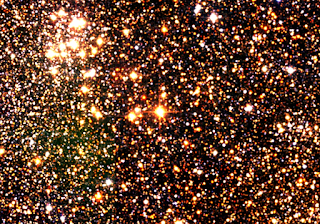Smallest Constellation with Biggest Stars
Today we will see Scutum-the Smallest Constellation with Biggest Stars.
Its name in Latin is for shield.
The neighboring constellations are Aquila, Sagittarius and Serpens Cauda.
The constellation boundaries are defined by a quadrilateral,diamond shaped.
A scute or scutum is a bony external plate or scale overlaid with horn, as on the shell of a turtle, the skin of crocodilians, and the feet of birds.
Scutum is depicted as a shield, whose corners are marked by its four brightest stars, though these are of only fourth and fifth magnitude. Despite its small size and faintness, Scutum does have several deep sky objects of interest. ... Scutum contains the following Messier objects: M11, M26.
The Polish astronomer Johannes Hevelius, who created the constellation in 1684, named it Scutum Sobiescianum, or Shield of Sobieski, to commemorate the king’s victory in the Battle of Vienna in 1683. King John III Sobieski also helped Hevelius rebuild his observatory after a fire in 1679.
Though the constellation is small, it contains one of the largest stars.
UY Scuti is a red supergiant star located in the constellation Scutum. It is one of the largest known stars, discovered since 1860.
- Data revealed that UY Scuti was around 7 to 10 times more massive than our Sun, and had a radius approximately 1.700 times larger.
Cl* Stephenson 2 DFK 01 or St2-18
The star is a member of the Stephenson-2 Star Cluster. The cluster is named after American astronomer Charles Stephenson who either located it or predicted it. The actual reason has not been identified by the site admninistrators.
The Stephenson-2 cluster contains some of the largest stars that are currently known. It is believed that one or many of the stars is possibly larger than UY Scuti which is also in the same constellation. UY Scuti is not a member of the Stephenson 2 star cluster.
Comparison of the sizes of selected different stars. From left to right are Cygnus OB2 #12, V382 Carinae, V915 Scorpii, UY Scuti and Stephenson 2-18.
Orbits of Saturn and Neptune are also shown for comparison.
on an evening in late July or August, look for Scutum in the Northern Hemisphere’s southern sky. Or look overhead as seen from the Southern Hemisphere,. You’ll be looking toward the richest part of our Milky Way galaxy. In fact, when we look this way, we’re looking not far from the famous Teapot pattern in the constellation Sagittarius. The Teapot marks the direction of the center of our Milky Way galaxy.
Scutum doesn’t mark the exact center of the galaxy, but it’s pretty close!
The very noticeable Teapot of Sagittarius is below Scutum. And the bright star Vega shines high above Scutum.











Beautiful
ReplyDelete